When to plant a garden hydrangea. Hydrangea paniculata: secrets of care and reproduction
Under natural conditions, this plant is very common in rare forests and edges of China, Japan and southern Sakhalin. Panicle hydrangea is a small tree that looks like a large shrub with a dense crown. The leaves are elongated, especially on the lower side and along the veins, rather large - about 12 centimeters long, oval in shape. Hydrangea blooms in small - up to 3 centimeters in diameter flowers white, which eventually turn into fruits. The fruit is small, up to 3 mm. capsules, by the time of ripening - by about October, cracks at their top and scatters the smallest seeds.
In addition to its decorativeness, hydrangea paniculata - hydrangea paniculata is described as a good honey plant and throughout the entire flowering, from mid-summer to mid-autumn, it supplies bees with high-quality raw materials. Such honey plants are collected in large paniculate inflorescences, reaching a third of a meter in length.
Hydrangea flowers are very interesting for their changing color. As they develop, they turn from cream to snow-white, and then gradually acquire pink tint, which towards the end of flowering, closer to autumn, smoothly turns into red-green.
Almost all hydrangeas have similar growing requirements. Differences are only in resistance to frost and demanding lighting, but only to a small extent. Consider below the general rules for caring for hydrangeas, common to all varieties.
Landing
The most satisfactory results are obtained when planting hydrangeas in the spring. You can plant a plant in the autumn, but in winter frost conditions it will be more difficult for it to take root, and besides, you will have to take care of reliable insulation of autumn seedlings. At the same time, by planting a tree in spring, in a warm, sunny period, you give the hydrangea a chance for the most comfortable rooting, and this ultimately guarantees that the tree will grow healthy and bloom fully, and most likely this season.
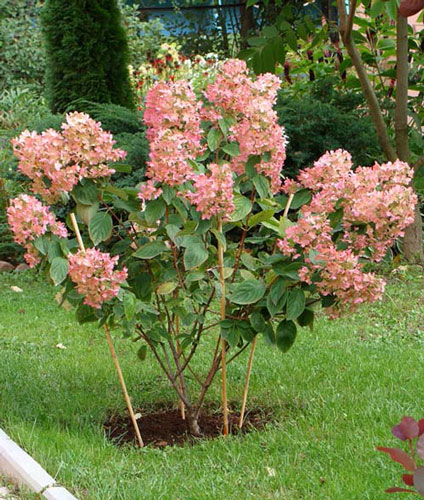
What you need to know to choose the right site
Like most ornamental trees, hydrangea loves when there is a lot of light and little winds, especially it does not like through and cold winds. These are the most significant factors to consider when growing it.
Most hydrangeas, including hydrangea paniculata, grow quite tolerably in partial shade and even in shaded areas, but you need to understand that under these conditions, its development will not be completely full, and the flowering is not so abundant and more faded. Therefore, if possible, you need to grow them in areas of light, not shaded by the crowns of large trees.
It is also worth considering that this plant requires a sufficiently nutritious soil, which excludes its planting on poor soils - sandy. Before planting, they will have to be prepared and subsequently, to carry out regular feeding, especially in spring and autumn.

First of all, in the selected area, you need to prepare a landing hole. Its size should correspond to the size of the root system of the seedling. Since hydrangea is a rather large shrub, the size of the hole should not be less than 60 centimeters in diameter and about the same depth, but it is better to make it bigger - this will allow you to lay more fertilized soil in it, which means that it will provide the plant with nutrients for a longer time. The optimal size is 80/70 centimeters.
In the dug hole, depending on its size, pour 20-30 liters of water and wait until it is well absorbed - until the next morning. The shattered hole is filled with prepared soil, the approximate composition of which is a mixture of horse and sod land, humus, peat and sand in proportions - 2/1/2/1. All this must be fertilized with organic matter and mineral compounds. Must be present - urea, superphosphate and potassium sulfate. It is desirable that the soil is slightly acidified. This can be achieved by adding pine or spruce needles to the mixture. But, as far as lime is concerned, it should not be at all - hydrangea reacts extremely negatively to it. Lime is guaranteed to lead to disease, and if its concentration is significant, then to the death of the plant.
The next step is to plant a seedling. Before planting it, you need to properly trim it. It is made depending on the type of hydrangea. If it grows in the form of a tree, its roots must be shortened, and on the aboveground part, all annuals are needed so that no more than 4 - 5 growth points remain on them. If this is a plant with a bushy crown, the sapling cannot be cut, since all its color-forming buds grow at the end of the shoots - they cannot be touched categorically.
The prepared seedling is planted and sprinkled with soil and then gradually tamped. First, they are rammed from the outer perimeter of the fossa, and then they gradually move to the trunk. In this case, it is worth making sure that the root collar does not fall below the soil level. If this happens, the seedling needs to be removed and transplanted again, since deepening the neck will almost certainly lead to the death of the seedling - its trunk will rot and the plant will disappear. It is advisable to carry out this procedure in spring or autumn.
As already mentioned, hydrangea must be grown on acidic soils, therefore, after planting and watering the seedling, it is worth mulching the soil with humus, sour peat or needles. In addition to increasing acidity, such ukrov will prevent premature evaporation of moisture and help the seedling adapt faster to new conditions. In addition to mulching, a young hydrangea requires reliable protection from winds and drafts, as well as from the scorching sun. At first, it is very desirable that the light be diffused.
Hdrangea paniculata, like its other varieties, is completely unpretentious and grows quite tolerably even without much care, but if you want to see the full completeness of its decorative effect, you will have to provide the plant proper care... It will be discussed below.
Watering
All hydrangeas, regardless of the variety, love moisture, therefore they require regular moisture, and quite substantial. An adult plant requires weekly watering - at least three buckets per square meter of soil around the plant. Regular watering is especially important if the bush grows in an open, sunny place and on hot summer days. The plant does not make any special demands on the quality of water, but it will be nice, for preventive purposes, sometimes add a little potassium permanganate to it - so that the solution is slightly pink. This will be a good prevention of root fungus and root decay.
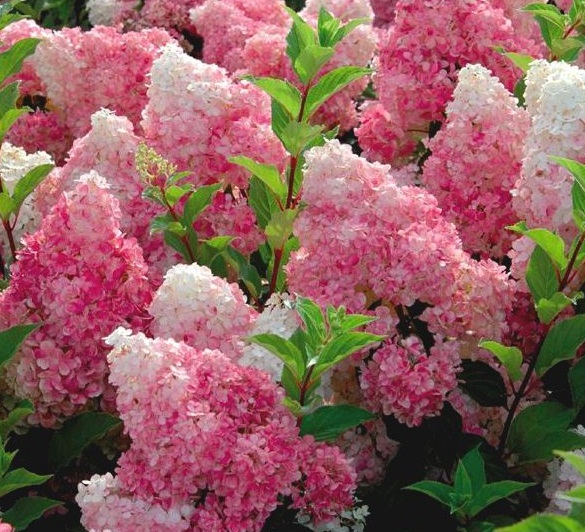
Regular irrigation is especially important on very light - sandy soils, which evaporate moisture very easily. In this situation, it is worth monitoring the humidity especially carefully - it is undesirable to allow drying out. Proper mulching holds moisture very well, therefore, after each watering, cover the soil around the trunk with sawdust or dry peat, but only so that it can breathe, otherwise it may rot and rot.
As for overflow, most varieties of hydrangeas are not very sensitive to them. The exception, perhaps, is panicle hydrangea, but they tolerate temporary drought better than others.
Lighting
All hydrangeas love a lot of natural light, and panicle hydrangea is the most photophilous - it prefers bright sunlight, but provided there is sufficient air humidity. If the air is dry, it will be better to ensure at least a slight dispersion of sunlight, otherwise the foliage will lose some of its decorative effect.
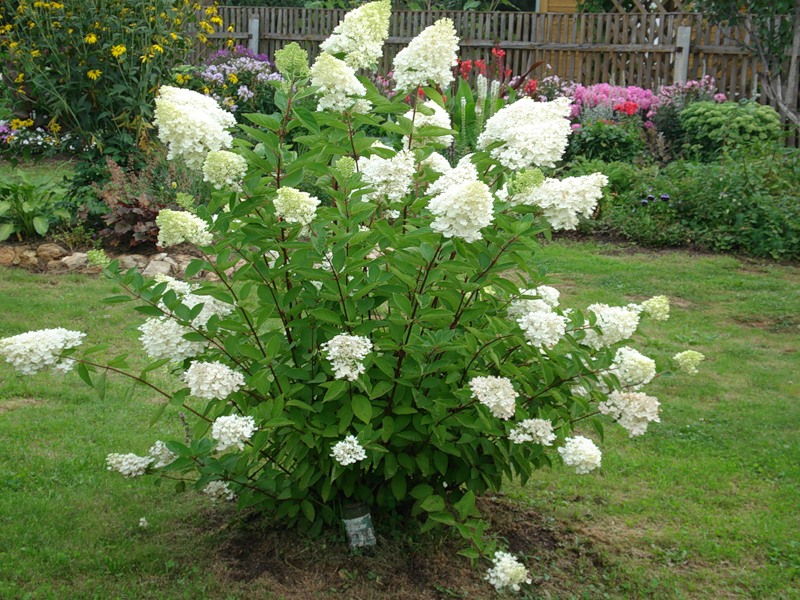
Optimum temperature
It all depends on the type of plant. So, for example, a tree hydrangea easily freezes in winter if it is not insulated, but quickly recovers with the onset of warmth. True, some of the branches will have to be cut, which spoils the crown. But, panicle hydrangea is quite frost-resistant - it easily tolerates frosts down to minus 40 and does not require crown insulation at all. But it will still be better to insulate the root system, because if the winter is snowless, the plant may freeze and will not bloom in due time.
The most vulnerable to frost, hydrangea varieties - serrate and large-leaved. They require insulation not only of the roots, but of the entire crown, otherwise the buds from which the flowers develop are guaranteed to freeze and die off, and the plant itself takes a long time to recover and may not bloom from one to three years.
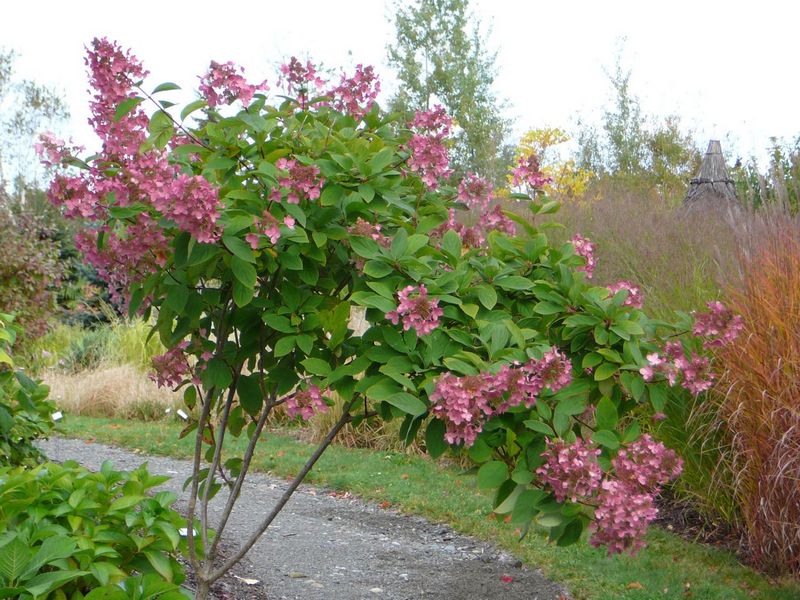
Soil quality requirements
The approximate composition of the soil has already been described in the previous chapter - panicle hydrangea - planting. Now let's dwell on some of the features.
The acidity of the soil is of great importance, since when it is insufficient, chlorosis often arises and develops - the leaves turn pale and then turn yellow.
When feeding, it is advisable not to use nitrogen fertilizers, especially before wintering - nitrogen significantly reduces the winter hardiness of all varieties of hydrangeas. On the contrary, potash compounds increase it, and in addition cause more abundant flowering.
Do not add wood ash flour to the soil - it lowers its acidity, which means it is harmful to the plant.
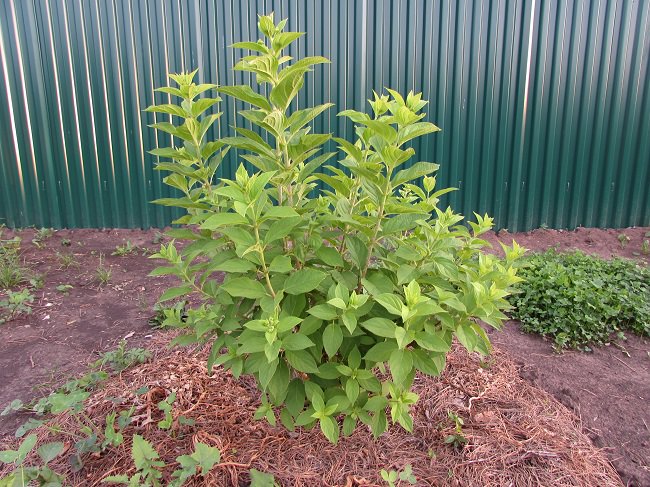
The concentration of some elements in the soil leads to a significant change in the color of flowers. So, an increase in substances rich in iron and aluminum leads to an increase in soil acidity and color of flowers in blue tones, and with a neutral and alkaline composition, hydrangea blooms in warm tones - pink and red.
Fertilizer
Like all large plants, hydrangeas need nutrients to thrive. Therefore, you need to regularly apply fertilizers - both organic matter and mineral compositions:
- Liquid manure is well suited from organic matter, but you should not get carried away, otherwise the plant will begin to increase its mass immoderately, and the inflorescences will become heavy and unbearable for the peduncles - they will break off under their own weight;
- It is advisable to use special minerals - for hydrangeas, and in a strict dosage specified by the manufacturer;
- To improve flowering and its abundance, it is worth adding under each bush about 25 grams of urea, 35 superphosphate and the same amount of potassium sulfate dissolved in water.
Such dressings are carried out four times during the warm season - from March to August inclusive. For the first time, you need to feed the hydrangea in early spring by introducing organic compounds. It will allow you to quickly build up green mass.
The second is needed for the development of emerging flower buds. At this time, you need to add superphosphate and urea.
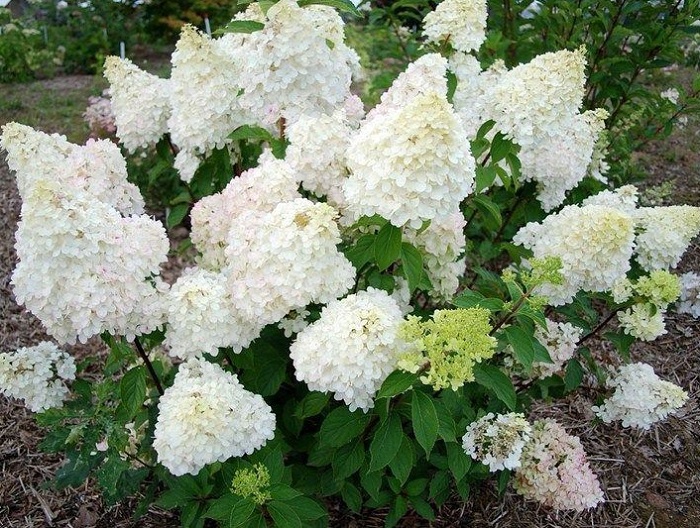
At the time of flowering, in order to prolong it as much as possible, the plant requires feeding mineral complexes... The last dressing is done with store formulations for hydrangeas. It is carried out in the fall before preparing the bush for wintering.
Crown care and shaping
The optimal time for such care is the end of March, beginning of April. Young hydrangeas leave no more than 10 shoots. The healthiest and strongest are chosen, cut them so that 4 - 5 points of growth remain on them. The rest of the shoots are cut at the root. If they are not cut off, they will only take strength from the bush and slow down its growth, so you should not feel sorry for them. Even if all the shoots seem to be good, you need to leave no more than 10, and even better 5 - 6.

Pruning a mature bush is carried out in a slightly different way. If it begins to bloom noticeably worse, it is advisable to cut off all its shoots to a size of 5-10 centimeters from the root. This will make the plant healthier and rejuvenated - for the next season it will actively grow and give abundant flowering.
Pruning can be carried out in the fall, but in this case it is limited to sanitary measures - diseased and damaged parts of the bush are removed.
Preparation for wintering
Despite its frost resistance, it will be better if the plant is prepared for winter in late autumn. First of all, you need to insulate the root system, which will not be superfluous in the event of a winter without snow. You can cover the roots with peat or sawdust, but rotted manure is best suited, which, in addition to heat, can also feed the plant in spring, when it gets warmer.
As for the insulation of the crown, whether or not to do it depends on the situation. An adult and frost-resistant plant can easily overwinter without insulation, but young growth, especially for the first winter, is still better to insulate. This should be done in late autumn, shortly before the onset of frost. For this, spruce or pine spruce branches, or garden fabric are suitable. True, in the latter case, you will have to make sure that it does not freeze, and if this happens you will have to clean it up, since it is completely airtight, and the plant needs to breathe.
If everything is done correctly, even first-year seedlings easily endure winter, begin to develop actively in spring, and give first flowers in summer.
Any gardener would like to have a beautiful flowering bush... fits perfectly into almost any landscape design... Its delicate luxurious inflorescences are delightful. Hydrangea looks very impressive when flower petals change color. It can be green, blue, red, pink, etc. This shrub came to us from distant Japan. Planting and caring for panicle hydrangea in the garden will not make you spend a lot of effort. This variety can withstand severe winter frosts and can grow even in an environment with increased gas pollution, that is, near the road.
Planting hydrangea paniculata
Shrubs are planted by cuttings. The soil for hydrangea should not be sandy, and also contain alkaline elements (lime, ash, etc.). You need to choose a place with diffused light and high humidity. Please note that the shrub does not tolerate drafts, so it is better to plant a panicle hydrangea near a fence or at home. Also, you should remember that its roots grow quite quickly, so other bulbous plants cannot be neighbors of the paniculate in the garden.
The stalk is planted at the end of March, so that the root system has time to get stronger before cold times. Dig a hole 25 cm in diameter and about half a meter deep. When planting, you need to fill up a young shrub with earth with drainage. After 10 days, the hydrangea will begin to grow. If you want to plant several bushes next to each other, then keep the distance between them 2 - 3 m.
Growing hydrangea paniculata
This bush grows quickly enough with the correct carrying out of some garden work. Caring for hydrangea paniculata in the garden is necrotic, requires a minimum of effort. After you have planted a bush in the soil, you need to follow the basic aspects:
- Watering... Hydrangea paniculata is a rather moisture-loving plant, so it needs to be watered every other day with plenty of water, and in hot weather it should be additionally sprinkled.
- Fertilizer... In order for the bush to grow quickly, you need to feed it once every two weeks with mineral mixtures for flowering or mullein infusion.
- Weeding... In this, the hydrangea is not whimsical, but still, so that moisture and air pass to the roots, loosen the ground at least once a month.
- Garter... A young hydrangea may not be able to withstand heavy buds and bend over, so tie it around the diameter when the buds are ejected.
Now you know how to care for panicle hydrangea and if you do everything right, then at the end of summer you will be able to admire its beautiful inflorescences.
Pruning and reproduction
If you want the bush to look beautiful and luxurious, then prune it periodically. Use garden scissors to remove the shoots from the hydrangea to 3-4 buds so that the bush will release new branches and be lush. Also, this procedure is carried out in order to rejuvenate, but on each branch.
If you want to have many bushes of such beauties on your site, then you need to know how to properly propagate panicle hydrangea. This can be done by grafting. Collect the desired number of spring shoots and plant them directly into the ground. Drizzle with special growth preparations such as Kornevin. After a week, the cuttings will begin to harden and grow roots. This must be done in June, otherwise the plant will not take root. Water the seedlings regularly and keep them in the shade. In the second year, do not let the plant bloom, cut off the branches so that it grows.
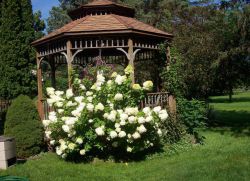
Transfer
It is possible that your shrub will grow poorly after planting or show little color. In such cases, consider changing its location. You need to know how to properly transplant panicle hydrangea so as not to destroy the bush. This is usually done before the flowering period, in the first half of summer. If the plant is more than three years old, rejuvenate it first. Step back a meter from the base of the bush and dig it out. Pour a mineral solution into the soil before planting. If during digging you cut off the root system a little, then do not worry, it grows back quickly enough.
Hydrangea is one of the gardeners' favorite flowering shrubs. The gorgeous inflorescences that adorn the bush from mid-summer to late autumn have a bewitching effect on a person. Hydrangea is very thermophilic, and only a few of its dozens of varieties can be planted in middle lane our country. Among them - garden panicle hydrangea... Planting and leaving in open ground- this is today's topic on our website about.
Hydrangea paniculata: basic information
In their natural habitat (Japan, China), hydrangea bushes reach 4 meters in height. In our conditions, it is possible to grow a plant from 1 to 2 meters. Inflorescences of paniculate garden hydrangea have a beautiful pyramid shape. They can be white, pink, or purple. The ability of flowers to change their original color is noteworthy.
Panicle hydrangea is characterized by rapid growth, shade tolerance and frost resistance. True, in order not to let the kidneys disappear, the bush should be covered for the winter. It is interesting that after planting one of the varieties of paniculate garden hydrangea, depending on the care (pruning), you can have both a bush and a small standard tree.
Paniculata hydrangea has many varieties. The most famous of them are shown below in the photos. By choosing the variety you like for planting on your backyard or summer cottage, do not rush to get down to business. First, you need to clarify whether your garden soil is suitable for the plant and the place that you plan to allocate for it. In addition, you should find out all the features of planting hydrangea paniculata and caring for it. You can find out about this by reading further.
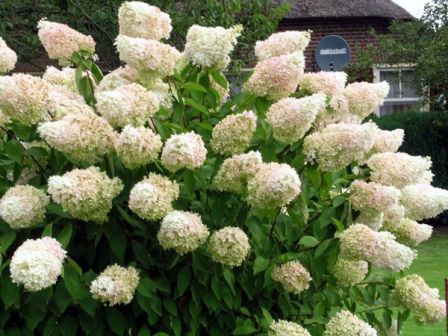 Hydrangea Grandifor - often found outdoors in our latitudes
Hydrangea Grandifor - often found outdoors in our latitudes 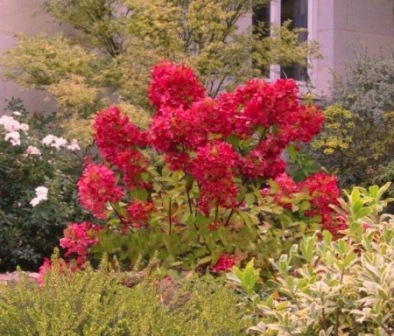 Dimont Rouge variety
Dimont Rouge variety 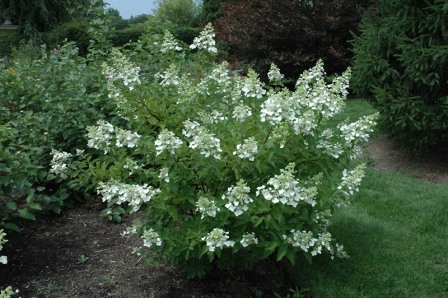 Hydrangea paniculata garden varieties Unique
Hydrangea paniculata garden varieties Unique 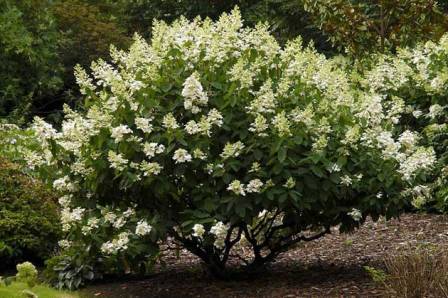 Hydrangea Kyushu
Hydrangea Kyushu Features of planting hydrangea paniculata
Suitable soil for panicle hydrangea. This flowering shrub will feel great when the roots are in fertile clayey acidic soil. If it is alkaline, the shrub will grow rather slowly and have pale flowers. How to make the soil more acidic? By adding peat, sawdust or pine needles to it.
The right place to plant paniculata hydrangea. All varieties of this type of shrub love partial shade. This does not mean that it should be planted under trees, but when located in an area completely exposed to direct sunlight, the shrub will not look as chic as it could.
Planting period of hydrangea paniculata. The best time to do this is in the spring. If you live in a region with mild winters, then autumn is just as good. But this is provided that it is warm.

Features of planting a seedling. At the time of transplantation, the panicle hydrangea seedling should be 3 or 4 years old. The selected place must be completely cleaned and dug up. Careful disposal of all roots will simplify further care. For single plantings, holes are dug 40-50 cm deep and 50-70 cm wide. You need to focus on the volume of the root system, although if the roots are freed from the ground, they can be pruned. To create a hedge, a trench is dug from the hydrangea of the same depth. Then everything is simple: they place the roots in the hole, cover them with earth, tamp them down and water them abundantly. Immediately after planting, the bushes are cut off, leaving 3-5 buds on each branch.
Rules for caring for hydrangea paniculata in the open field
Watering the bush
For the inflorescences to be lush and bright, the hydrangea needs to be watered often. It is best to create conditions for the shrub in which the earth will never dry out. A good help with this is peat or compost mulch.
Garden soil treatment
Hydrangea care will be of poor quality if you do not provide regular loosening of the soil around the bush. This is necessary to retain moisture and air penetration to the roots. At the same time, remember that the root system of the bush is quite extensive. Naturally, weeds should not be allowed to grow near the hydrangea.
Top dressing of hydrangea paniculata
With a lack of nutrients in the soil, you should not count on the beautiful and abundant flowering of panicle hydrangea. That is why special attention should be paid to feeding. So, in the spring, at the beginning of the growing season, good result gives watering the bush with a bucket of water with the addition of 20 g of urea. Many gardeners also praise nettle infusion as a spring fertilizer for hydrangeas.
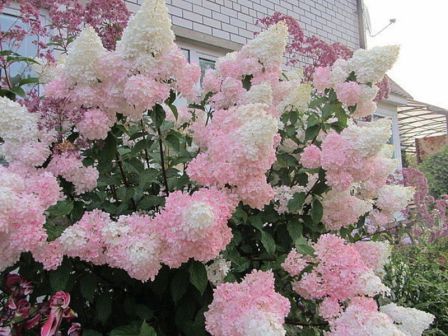
I really like hydrangea mullein, diluted with water
It can be applied under the bush every two weeks. When buds appear to stimulate flowering, two dressings are carried out using mineral fertilizers, observing a break between them for at least 2 weeks.
Pruning hydrangea paniculata
As already noted, the first pruning of the bush should be done immediately after planting. When should you start doing this next time? During the flowering period, the bush should not be touched, therefore, you should wait until autumn for pruning. First of all, you need to cut off all dried inflorescences. In addition, in the fall, you can thin out the bush if it is heavily overgrown.
The next pruning is done in the fall before bud break. Now you should remove all broken branches damaged by frost. In pursuit of an aesthetic goal, you can cut off shoots that grow incorrectly. It is also worth shortening annual shoots by a third. Good way to rejuvenate the old hydrangea bush - cut off all the shoots to the base in the spring.
Shelter hydrangea for the winter
Without shelter, the buds on panicle hydrangea can freeze out. In the southernmost regions, it is enough to simply huddle the bush high. But where winters are cold, more drastic measures are needed. It is best to gently bend the shoots, secure them with staples, and then cover them with peat, cover with spruce branches and cover with foil.

Reproduction of hydrangea
The most popular way to propagate hydrangea outdoors is grafting... Cuttings are best prepared in early June from the lower shoots on the trunk. Each of them should have at least 3 buds, the optimal length is 10 cm. The cut should be at a distance of 2 cm from the lower bud. For two days they need to be soaked in a growth stimulator. Then they are planted in containers with peat and sand, covered with plastic or glass containers and make sure that the moisture does not evaporate completely. After a month, the cuttings will begin to take root. They can be transplanted into open ground at the end of next summer.
Gardeners also often resort to hydrangea propagation. layering... To do this, a hole with a depth of 20 cm is made near an adult bush. Next, you should bend it to it, fix it with a metal bracket and sprinkle one of the lower annual shoots with earth. The top should be vertical. In the place of the future appearance of the roots, the shoot must be incised or the bark must be removed in this area. We must not forget to water the cuttings along with an adult bush. If rooting is successful, it can be planted in a year.
Mature shrubs with a good root system can be propagated by division... It is worth digging it up for this in early spring or in September. Several buds should remain on each formed part.
Planting hydrangea paniculata
Most likely, you will be planting an already grown hydrangea seedling. It can be bought from many shops that specialize in flowers. But they can be imported, not adapted to our conditions. Therefore, in my opinion, seedlings purchased from local agricultural firms and flower-growing complexes take root better.
It is best to plant a Hydrangea paniculata sapling 4-5 years old in a permanent place. It takes root well and begins to bloom faster.
 Most varieties of Hydrangea paniculata are planted in open ground. Indeed, as a result, a tree can grow up to 10 m tall. But there are also low-growing varieties - up to 2 meters, for example, Hydrangea paniculata Magical Fire - it can even be planted in a large flowerpot.
Most varieties of Hydrangea paniculata are planted in open ground. Indeed, as a result, a tree can grow up to 10 m tall. But there are also low-growing varieties - up to 2 meters, for example, Hydrangea paniculata Magical Fire - it can even be planted in a large flowerpot.
Place for planting Hydrangea paniculata need to be prepared accordingly. This shrub has very branched roots - their borders are much larger than the diameter of the crown. Therefore, when planting, keep in mind that it will not be possible to plant bulbous flowers nearby: tulips, gladioli, hyacinths, which require annual digging of soil. At the same time, the roots themselves are located shallowly, therefore, it is best to allocate a site for Hydrangea paniculata, free from other plants. As a last resort, you can plant sedum or another plant covering the ground around.
 The dug planting hole should be sufficiently wide and of medium depth (approximately 60 cm wide and 40 cm deep). If you plant 2-3 bushes, then the distance between them should be at least 2.5-3 m.
The dug planting hole should be sufficiently wide and of medium depth (approximately 60 cm wide and 40 cm deep). If you plant 2-3 bushes, then the distance between them should be at least 2.5-3 m.
You can plant Paniculata Hydrangea both in autumn and spring. But in the northern regions, spring is still preferable - so that the roots get stronger by winter. The roots need to be shortened a little before planting. Shoots up to 3-4 pairs of buds are also cut off.
The soil needs acidic or neutral, while very fertile (suitable for rose bushes). Hydrangea paniculata does not tolerate the presence of lime or other alkaline compounds in the soil. V best case it will not bloom in such conditions, at worst it will simply perish. Therefore, it is impossible to add ash, lime, dolomite flour or chalk to the soil, even nearby, not far from the zone of the roots of Hortense.
But brown peat, sawdust or coniferous soil can be added to deoxidize the soil during planting. And mineral or organic fertilizers applied during planting contribute to the rapid growth of the Hydrangea bush and early flowering. As a rule, the first flowering and fruiting occurs at 4-5 years old. Hydrangea flowers are melliferous.
Panicle hydrangea is a lush, long-lived shrub. In a garden, with proper care, it can grow for up to fifty years. Gardeners love it for its simplicity and lush paniculate inflorescences, consisting of small flowers. On this page "Popularly about health", dear readers, you will find useful information and tips for growing this beautiful shrub in the garden.
Time and place for planting paniculate hydrangea garden on the site
If you have already purchased panicle hydrangea seedlings, then you need to decide on its permanent place in the garden. The shrub will be grateful if you find a sunny place for it, sheltered from the wind. In partial shade, hydrangea also grows normally, but a solid shadow is contraindicated for the bush - the inflorescences will be small and unsightly. The optimal time for planting a plant in the ground is early-mid April, when it gets warmer every day, and night frosts do not threaten. In cold regions, it is worth postponing the planting of seedlings until a later time.
In the photo, hydrangea paniculata
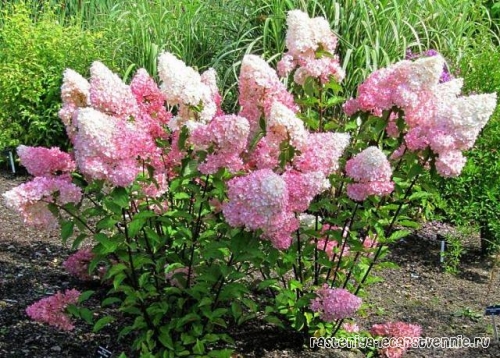
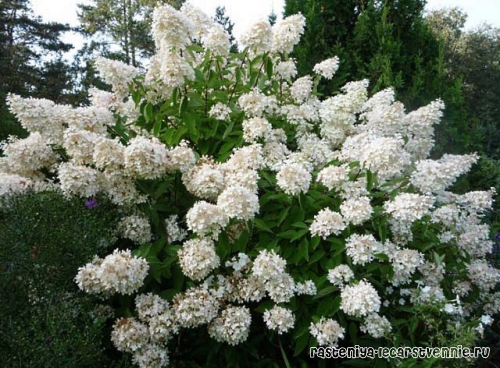
Planting hydrangeas in the ground
So, you have decided on a place in the garden, now is the time to prepare holes for each seedling. Dig a hole, which would be at least 40 cm deep, and its width would be 50 cm. In the evening, pour a bucket of water into it so that the moisture will completely saturate the soil by morning. Mix the soil from the pit with humus, peat and sand (proportion 2: 2: 1). To this we add urea (25 g), the same amount of potassium sulfate and superphosphate (65 g). Hydrangea prefers acidic soil, so it would be appropriate to lay a layer of needles on the bottom of the pit. Fill the pit by a third with the prepared potting mix. At least one and a half meters of free space is left between the holes, since over time the hydrangea bush becomes voluminous and lush.
Now we will prepare the seedlings themselves for planting. First, the paniculate hydrangea seedlings need to shorten the roots. Along with this, they also prune annual shoots so that from 3 to 5 buds are preserved on the remaining branches. Place the seedling in the hole, submerging it in the soil at the level of the root collar. Fill the hole with earth, compact it lightly and water. It is better to mulch the trunk circle with peat and needles. Mulch will act as an obstacle to the rapid evaporation of moisture.
Care for hydrangea paniculata in the open field
Shrub care includes abundant watering, timely pruning of shoots, top dressing, and preparation for wintering. Let's consider everything in order.
Watering
Hydrangea needs abundant watering. The soil around the bushes should not be allowed to dry out. During extreme heat, it is recommended to pour up to 30 liters of water under each plant.
Top dressing
Hydrangea is fed at least 4 times per season. The first feeding is introduced in early spring, when sap flow begins. At this time, organic matter is introduced under the root. When buds are laid, a composition of urea, potassium and superphosphate is added. During flowering, which occurs in the middle of summer, complex mineral fertilizers are introduced. In the fall, hydrangea bushes do not need to be fed, but some gardeners still introduce fertilizer with a low nitrogen content, after which they prepare the plant for wintering.
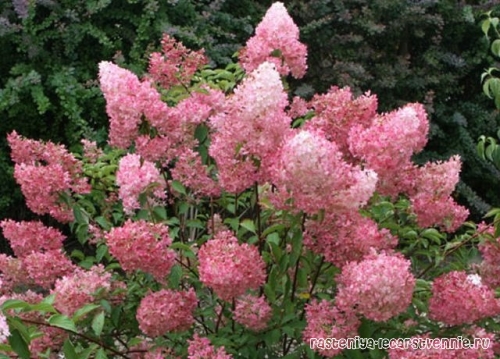
Pruning
Many new shoots form at the base of the hydrangea bush every year. Of these, you need to choose about 6-8 pieces of the strongest and healthiest and cut them off, leaving only three to five buds. All other shoots are removed. Every spring, you need to inspect the branches and remove all shoots that have rotted or frozen over the winter. Old bushes are rejuvenated by pruning the shoots under a stump (only 6-7 cm are left).
Wintering
Although in the open field, panicle hydrangea tolerates frost well, nevertheless, if you grow it in cold climates, it would be advisable to cover the root system for the winter. To do this, use rotted manure or dry foliage with peat.
Diseases, pests
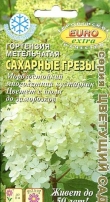 Experienced gardeners note that hydrangea suffers most from pest attacks in the first three years of life in the garden. Hydrangea paniculata can be affected by powdery mildew - the leaves are covered with a gray bloom. To combat this ailment, special solutions are usually used with which the bushes are treated. For example, foundazol. About 25 grams of insecticide is diluted in a ten-liter bucket of water.
Experienced gardeners note that hydrangea suffers most from pest attacks in the first three years of life in the garden. Hydrangea paniculata can be affected by powdery mildew - the leaves are covered with a gray bloom. To combat this ailment, special solutions are usually used with which the bushes are treated. For example, foundazol. About 25 grams of insecticide is diluted in a ten-liter bucket of water.
Another pest that affects hydrangea is aphid. This insect is afraid of the smell of garlic. Just prepare a tincture from it like this - peel and grind about 300 grams of the product, fill it with water (10 l). Let the liquid stand for two days. Next, take a small piece laundry soap(50 g), rub it on a grater and add to the garlic infusion. When the soap is completely dissolved, you need to spray the bushes with such a medicine every day until the pest disappears completely.
As you can see, everyone who is fond of flowers and horticultural crops can grow this beautiful shrub. Caring for a hydrangea is not difficult - with a minimum of effort, the gardener gets a luxuriously flowering bush that will delight the eye for many years. If you want to grow this plant in your garden, then now is the best time to buy seedlings.




